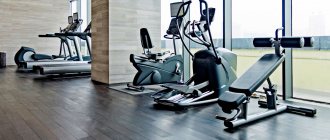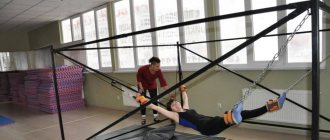April 1, 2020 Admin Home page » Tips and tricks
Find out whether it makes sense to use bandages for squats, what are their benefits, or, conversely, the pointlessness of using them.
I’ll say right away that bandages are recommended for those who use record weights, but are they necessary for those who do not claim records or do not compete? Lately, some people have formed the opinion that if you wrap your knees in bandages, it will improve your squatting technique and help you lift more working weight, while some are simply “showing off”, look how cool I am, in order to attract the attention of other gym goers.
Most gym goers using bandages are not based on the following opinion:
How bandages help athletes
Many powerlifters use wrapping without any understanding of its actual purpose. The idea is to locally improve blood supply at the site where the bandages are applied and increase the stability of the joint.
For squats, knee bands are used almost constantly, since just one turn of the band around this joint allows the athlete to lift a weight of 4 kg more than usual. A standard two-meter bandage is wound in several turns and already gives from 25 to 35 kg of additional weight for lifting.
Compression bandage "Intex" for squats without weights: why is it needed and how to choose?
Squats are a natural exercise for the body that work the muscles in your thighs, calves, and buttocks. To fully work out your legs, you need to do 80-100 repetitions in one session. This is a big load on the muscles and the knee joint.
The compression bandage relieves the knee ligaments and supports the knee , accelerates blood flow in the legs, improving nutrition of the growing muscles. “At the same time,” lactic acid is removed from the legs, a substance familiar to athletes, which causes severe muscle soreness the morning after training.
For squats without weights, use an elastic band with a high degree of elongation (150%), 1.5-2 m long and 8-10 cm wide.
There are no strict rules for applying a bandage. The main thing is not to pull the tape too tightly so that the blood does not stagnate. The best results can be achieved when the rounds (turns) of the bandage overlap each other by a third of the width and cover the leg from the middle of the shin to the middle of the thigh.
Negative aspects of using bandages
The disadvantages of squat bands relate to both physical and psychological aspects of the powerlifter's condition. In physical terms, discomfort can be caused by an overly tight bandage, which can even cause injury to the kneecap itself. The cause of damage in this case is the movements of the bones in the joint that are in too close contact, which are produced when it opens and closes.
Psychological dependence is expressed primarily in getting used to lifting heavy weights only with the use of bandages. Athletes call this a kind of “cheating,” which allows them to overcome “dead zones” and maximally load the muscles.
Professionals do not recommend using bandages on an ongoing basis. Constant use of bandages leads to the fact that the athlete is no longer able to lift similar heavy weights due to a combination of physical and psychological problems.
Main function
A high-quality knee wrap is designed to prevent the risk of damage to the knee joint under heavy loads during training.
Statistics show: using knee bandages reduces the likelihood of injury by 2 times.
Useful properties of knee bandages:
- Increase blood circulation in joints;
- Distributes the load evenly;
- Act as a stabilizer and fixator, which prevents the joint from moving to the side under load;
- Reduce the risk of sprains;
- Reduce pain.
Most often, powerlifters use knee wraps for barbell squats. They make it easier for the athlete to rise after a squat, and also prevent “sagging” at the bottom point when squatting.
Athletes also use these bandages in other sports: football, wrestling, running, high jumping.
It is necessary to use bandages after injuries. This allows you to avoid repeated injuries, as well as the formation of blood clots and inflammation.
Instructions for bandaging knee joints
All the benefits of using bandages will definitely be nullified if you do not know the simple principles of how to wrap squat bandages. This step-by-step instruction will be useful for both beginners and experienced athletes:
- You need to sit down and stretch one leg straight. Before competitions, you should rub your knees with chalk.
- The bandage starts under the kneecap. The left leg is wrapped counterclockwise, and the right leg clockwise. Three quarters of the previous turn should always be covered by the next one. The winding goes from bottom to top and gradually covers the entire knee. The last turn is wound when the distance between its borders and the knee is equal to the width of the bandage itself.
- The next element is a control revolution around the last turn. Next, a crosswise turn is made to strengthen the lower part of the cup, and then a similar turn is made, but upward. This way the space above the kneecap is covered. From this position at the top you need to continue bandaging with straight turns.
- The product must be secured by inserting the thumb between the leg and the bandage. The finger will leave an area where the end of the bandage is pulled into.
- This fixation makes it easy to unwind the bandage by simply pulling out its end.
How to properly wrap squat bands
Method No. 1
First of all, take a comfortable position, stretch your leg forward. Before bandaging, it is better to use chalk to rub your knees.
The beginning of the tour always occurs below the articular surface. On the right leg, the bandage moves clockwise, on the left leg, counterclockwise.
With each round you need to rise higher so that the bandage covers the previous one by ½.
After the last round (when the distance of the turns from the joint is equal to the approximate width of the product itself), it is necessary to perform a securing turn.
After this, you need to bandage the cup crosswise to strengthen the lateral ligaments.
Fastening the bandage is very simple - just place the end of the bandage under the last turn. And this technique allows you to check the strength and degree of fixation and makes it easier to unwind the knee after the exercise.
Method No. 2
Rules for using squat bands
You should always wisely divide the time you work with and without bandages. Not every squat exercise requires knee wraps. However, if an athlete has chronic injuries to the meniscus and ligamentous apparatus, then permanent fixation is absolutely necessary for technically correct execution of the exercises.
Immediately before wrapping squat bands, be sure to warm up with light weights in the amount of 10-15 approaches. During squats, the main emphasis should be on quality, monitoring the technique and mechanics of movements. The winding should not be too tight; during breaks it is best to remove the bandage or at least temporarily loosen it. Bandages should be chosen only from elastic materials.
Nuances
It is necessary to mention that bandaging protects against damage to the ligament. And in most cases you have to choose between two evils. Some athletes have weak ligaments, so it is better for them to use a bandage. If the ligaments are healthy, it is better to avoid using it.
Recommendations
You shouldn’t give up using bandages completely. But work with them should be limited to the maximum. You should only wrap your knees before the heaviest approaches. Additionally, it weakens the hamstrings. Martial artists know this very well and practically do not use such taping.
The bandage should fit tightly to the leg and securely fix the knee. In this case, it will perform its main function - protecting the ligaments. Immediately after completing the approach, the bandage should be removed; you should not walk around in it for half the workout.
Types of bandages and methods of care
Bandages suitable for athletes are made from elastin, a special fabric with rubber threads. Elastic bandages are tightly fixed to the surface being wrapped and have high stretch rates. According to the degree of elasticity, bandages are divided into three types:
- With low elasticity. Stretches up to 40% of its own length.
- With medium elasticity. 100% stretchable (twice).
- With high elasticity. Stretches 150% (three times).
Cotton bandages are more pleasant for the skin, but many athletes choose synthetic options for their durability. It is quite easy to recognize unnatural devices: the surface will be too shiny compared to cotton products. Washing bandages made of any fabric is allowed only in cold water with gentle powders. Do not wash bandages in a machine or wring them out after washing.
The product is dried in a straightened state without using an iron. Storage is allowed in rolled form. When used correctly, squat wraps last on average about 5 years.
Knee bandages. What are they for and how to bandage your knees correctly?
Bandages are used in iron sports to protect strength athletes from injuries to the knee joints when performing squats
with submaximal weight. Why does this happen? But look:
- Bandages help you warm up faster;
- Allows you to retain heat longer (important if you rest for a long time between approaches);
- They stabilize the joint and reduce the load on the ligaments.
But these are not all the benefits that knee bandaging
. In addition to protecting against injury, bandages add strength potential to you: each oblique turn of the bandage adds a couple of kilograms of working weight, this is an advantage of 10 to 35 kg during squats (provided that your back is stronger than your legs). The validity of this statement was proven by a special study in 1990. Impressive?
Reference
: in the Technical Rules of the FPR (note by the Russian Powerlifting Federation), the ratio of the length and width of the knee bandages is strictly limited (8x200cm), which means that it is necessary to wrap not only correctly, but also “economically”.
How to properly bandage your knees
Tips for bandaging your knees
From a sitting position, straighten your left leg at the joint, fully extending it forward (you can put it on a support). Do not bend and maintain tension in the limb. Pull the toe of the foot towards you.
You need to start bandaging only with a rolled bandage and directly under the kneecap. You should bandage until you reach the width of the bandage above your knee. According to IPF (International Powerlifting Federation) rules, the total height of the bandage should not exceed 30 cm.
There are several bandaging schemes, watch the video
Disadvantages of bandaging
Injury Factor
When extending the knee, there must be freedom at certain points in the moving parts of the joint. Compressing these points under heavy load can lead to damage to the joint.
Addictive factor
Having initially gotten used to bandages, the athlete runs the risk of encountering certain difficulties when performing a squat. The reason is the ligaments that remain weakened while the working weights continue to increase. Once an athlete gives up bandages at least once, the usual weight will become unbearably heavy. Thus, many experience what is called “addiction” to equipment.
If you have healthy knees and are involved in amateur bodybuilding, then it is not necessary to use bandages
. In general, the advisability of bandaging can be considered if:
- You are not a newbie. (It is important for beginners to get used to the load and strengthen the ligamentous apparatus, and bandages just “switch off the ligaments from working.”)
- You can squat 1.5 body weights or more at a time.
In this case, you can use bandages, but only with heavy weights (80% of the maximum) and not often - about once or twice a month: this will give an additional boost to your strength indicators. By the way, the famous Canadian coach Charles Poliquin, who has “trained” more than one Olympic athlete, considers knee bandages to be the culprit for the slow development of the muscles of the back of the thigh. But the choice, naturally, is yours: we have listed the pros and cons of bandages. But powerlifters (those who squat for a record, that is, those who compete) and people with injured knees should definitely use bandages when performing squats.
How to choose the right bandages
The choice of bandages is an individual process for each athlete working with heavy weights. As athletes become more proficient and take on new bars, they typically move to using stiffer bands for heavy squats. Naturally, the additional 10-30 kg due to the use of a stiffer bandage will always be important for any powerlifter.
In terms of the rigidity of bandages, professionals advise choosing the golden mean and not going to extremes. An excessively tight bandage sometimes leads to injuries to the arteries and ligaments in the knee joint.
Today, elastic bandages are an integral attribute of every athlete working with heavy weights.
How to bandage
It is most effective to apply the bandage yourself. This way you will feel its tension much better. There is no need to make the fixation too tight, as this can impair blood circulation. The bandage should secure the knee joint well without restricting movement.
A little about the rules:
- there is no need to skimp on bandages; it is better to throw away old and stretched ones and buy new ones;
- The bandage must be applied evenly, so that the next layer half covers the previous one, without leaving gaps or unevenness;
- Before bandaging, do a warm-up;
- As soon as you have finished exercising with heavy loads, the bandage must be removed so as not to impair blood circulation.
Should I use weightlifting bands when squatting?
The barbell squat is a compound exercise, which means it uses a large number of large and small muscles, which allows you to work with large weights. If you are chasing the maximum result, then this creates a fairly high risk of injury (power sports are generally very dangerous for injuries).
When performing squats with a barbell, the main work is done by the muscles of the back and legs, and accordingly they are at risk of injury. If you need to use a weightlifting belt to prevent back injuries, then you need to protect your knees with weightlifting bandages.
In general, knees are rather delicate joints that should be protected from unnecessary stress. This applies, by the way, not only to strength training; for example, when running, these joints also place a lot of stress, especially if you are significantly overweight. Squats also put a lot of stress on your knees, so be careful.
But this does not mean that you need to immediately bandage your knees while performing any squats. You should only use bands when working with heavy weights and performing low reps. If you do a large number of repetitions with little weight for you, then there is no point in using bandages.
Firstly, in this case there is practically no risk of injury, and wrapping the bandages takes quite a lot of time, which can greatly increase the duration of the workout. Secondly, bands allow you to squat with a lot of weight, which is important for competitions, but in regular training with a large number of repetitions it is simply not necessary: after all, bands do not add strength or muscle size to you, which is the goal of strength training. Thirdly, muscles and ligaments must get used to the load, which is a guarantee against injury, and the constant use of bandages slows down or completely stops such habituation.
Read also: Timely consultation with an endocrinologist can save lives.
So you should only use bands when you are squatting with heavy weight. In this case, it is better to play it safe and take care of your joints. Bandages should also be used if you have any problems with the knee joint. But in this case, the first thing you need to do is see a doctor; most likely, you will have to take an x-ray.
Bandages are often rolled when knee pain occurs after or during barbell squats. In such cases, you need to understand that bandages themselves are not a universal cure for problems with the knee joint. Constant use of bandages can push the problem deeper and further injure the joint.
It is advisable to go to the doctor and get a consultation. Pain in the joints and muscles can be symptoms of overtraining, so it is advisable to take a week's break from training, which will never be superfluous.
In general, weightlifting bands are professional sports equipment, so in personal training they are only justified when working with heavy weights.
Source: Fitness style
Powerlifting Squat Equipment
Tights (suit) for squats
During training and competitions, athletes use overalls from three American companies: Inzer, Titan and Marathon. Depending on their habits, athletes use suits ranging from softer, more elastic ones, such as the “Inzer Champion Suit”, to the hardest “Golt Metal” from Marathon.
T-shirt (half-sleeve)
According to the technical rules of the competition, while performing squats, the athlete must wear a half-sleeve under his overalls. Some lifters wear a deadlift shirt. They explain this by saying that it helps them better fix their back in an arched state.
Powerlifting belt
A powerlifting belt is significantly different from a weightlifting belt. Width – 10 cm along the entire length, made of several layers of stitched or pressed hard leather. Leading manufacturers of excellent belts are Safe USA, Marathon, Inzer. Good quality belts are also produced in Russia, in Izhevsk.
Bandages for hands and knees
Currently, many athletes in squats use wrist bandages to secure the hand in a stationary state. According to technical rules, the permissible length of wrist bandages is 50 cm. It is practically difficult to meet an athlete who would not use knee bandages because, first of all, they protect the knee joints from injury. And secondly, with good squatting technique, they help when lowering the barbell and when standing up with it. According to the competition rules, you can use bandages that do not exceed a length of two meters and a width of 8 cm.











